International Trade Analysis: Economics Report on Italy and Sweden
VerifiedAdded on 2023/04/26
|10
|1120
|351
Report
AI Summary
This economics report provides an analysis of international trade dynamics between Italy and Sweden. The report begins with a data analysis section, comparing openness and GINI index values for both countries from 2003 to 2015. It calculates correlation coefficients and discusses the relationship between trade openness and income inequality. The report then applies economic theories such as the Stolper-Samuelson theorem to explain trade patterns, including specialization in labor-intensive goods. Technical analysis is performed using supply and demand models, opportunity cost analysis, and the construction of relative supply and demand curves to determine equilibrium prices and quantities under free trade. The report concludes with a discussion of the potential gains from trade for Italy and Sweden, offering insights into how each country can benefit from international trade. The student has provided the solution to the assignment to be published on the website Desklib.
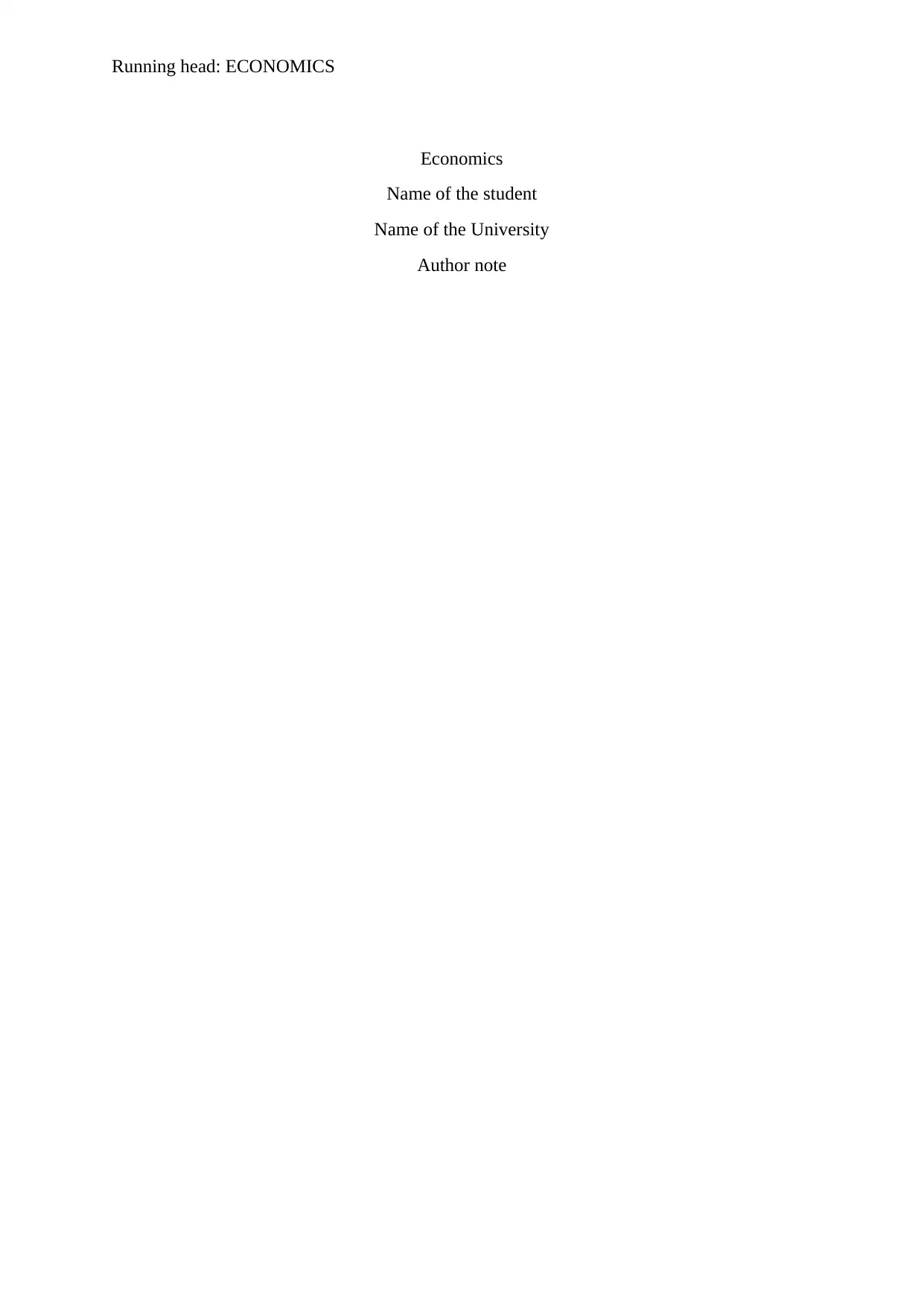
Running head: ECONOMICS
Economics
Name of the student
Name of the University
Author note
Economics
Name of the student
Name of the University
Author note
Paraphrase This Document
Need a fresh take? Get an instant paraphrase of this document with our AI Paraphraser
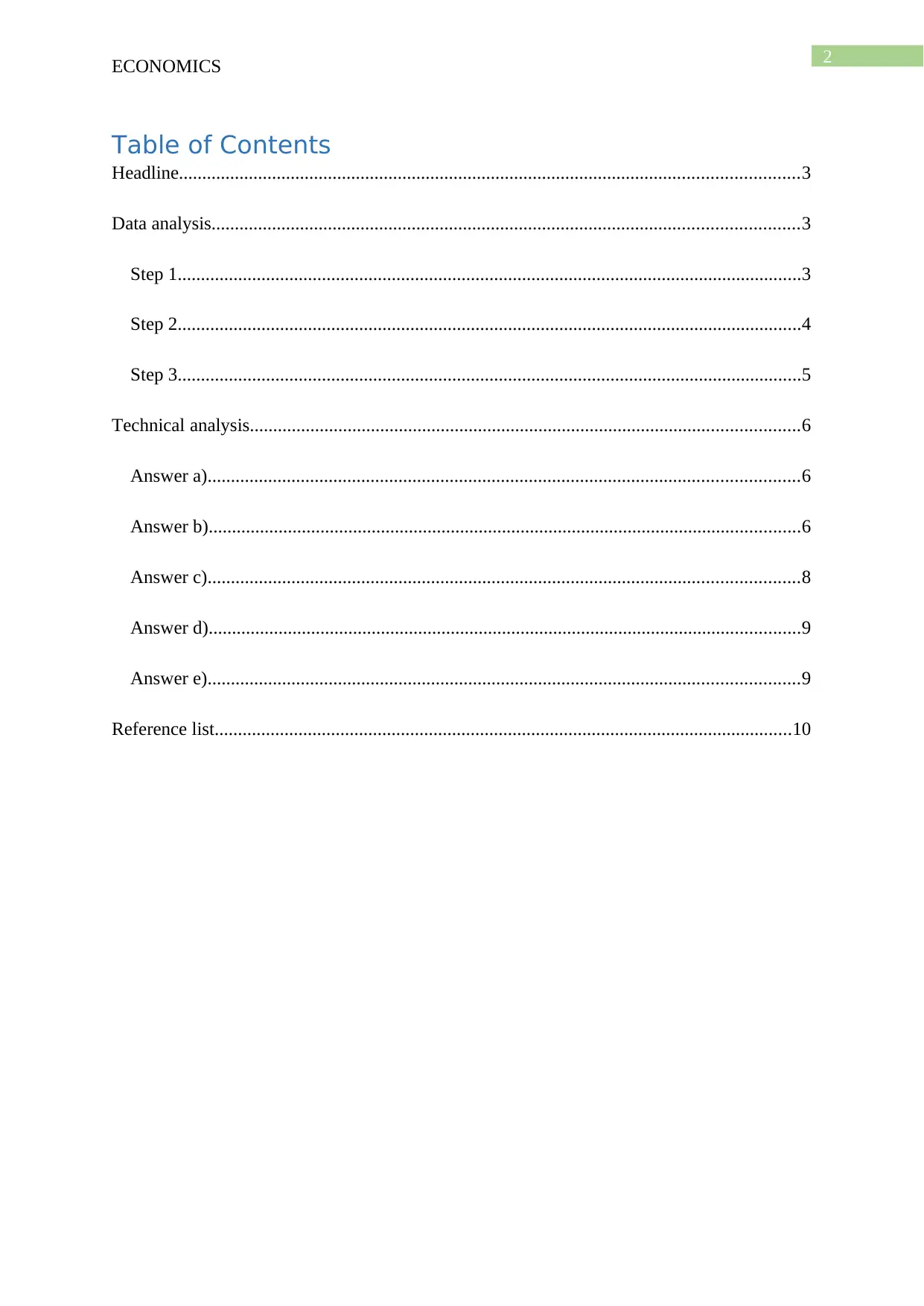
2
ECONOMICS
Table of Contents
Headline.....................................................................................................................................3
Data analysis..............................................................................................................................3
Step 1......................................................................................................................................3
Step 2......................................................................................................................................4
Step 3......................................................................................................................................5
Technical analysis......................................................................................................................6
Answer a)...............................................................................................................................6
Answer b)...............................................................................................................................6
Answer c)...............................................................................................................................8
Answer d)...............................................................................................................................9
Answer e)...............................................................................................................................9
Reference list............................................................................................................................10
ECONOMICS
Table of Contents
Headline.....................................................................................................................................3
Data analysis..............................................................................................................................3
Step 1......................................................................................................................................3
Step 2......................................................................................................................................4
Step 3......................................................................................................................................5
Technical analysis......................................................................................................................6
Answer a)...............................................................................................................................6
Answer b)...............................................................................................................................6
Answer c)...............................................................................................................................8
Answer d)...............................................................................................................................9
Answer e)...............................................................................................................................9
Reference list............................................................................................................................10
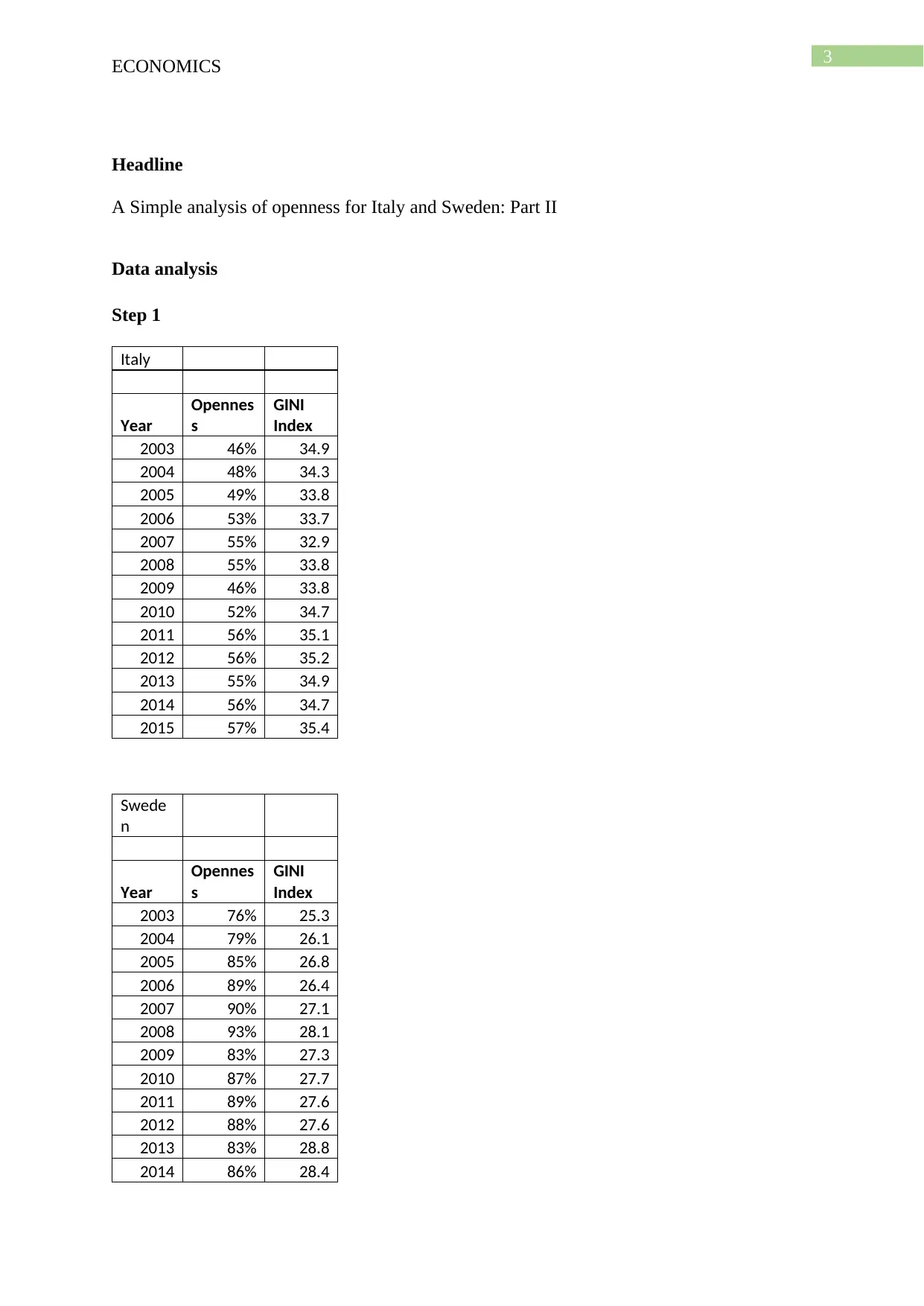
3
ECONOMICS
Headline
A Simple analysis of openness for Italy and Sweden: Part II
Data analysis
Step 1
Italy
Year
Opennes
s
GINI
Index
2003 46% 34.9
2004 48% 34.3
2005 49% 33.8
2006 53% 33.7
2007 55% 32.9
2008 55% 33.8
2009 46% 33.8
2010 52% 34.7
2011 56% 35.1
2012 56% 35.2
2013 55% 34.9
2014 56% 34.7
2015 57% 35.4
Swede
n
Year
Opennes
s
GINI
Index
2003 76% 25.3
2004 79% 26.1
2005 85% 26.8
2006 89% 26.4
2007 90% 27.1
2008 93% 28.1
2009 83% 27.3
2010 87% 27.7
2011 89% 27.6
2012 88% 27.6
2013 83% 28.8
2014 86% 28.4
ECONOMICS
Headline
A Simple analysis of openness for Italy and Sweden: Part II
Data analysis
Step 1
Italy
Year
Opennes
s
GINI
Index
2003 46% 34.9
2004 48% 34.3
2005 49% 33.8
2006 53% 33.7
2007 55% 32.9
2008 55% 33.8
2009 46% 33.8
2010 52% 34.7
2011 56% 35.1
2012 56% 35.2
2013 55% 34.9
2014 56% 34.7
2015 57% 35.4
Swede
n
Year
Opennes
s
GINI
Index
2003 76% 25.3
2004 79% 26.1
2005 85% 26.8
2006 89% 26.4
2007 90% 27.1
2008 93% 28.1
2009 83% 27.3
2010 87% 27.7
2011 89% 27.6
2012 88% 27.6
2013 83% 28.8
2014 86% 28.4
⊘ This is a preview!⊘
Do you want full access?
Subscribe today to unlock all pages.

Trusted by 1+ million students worldwide
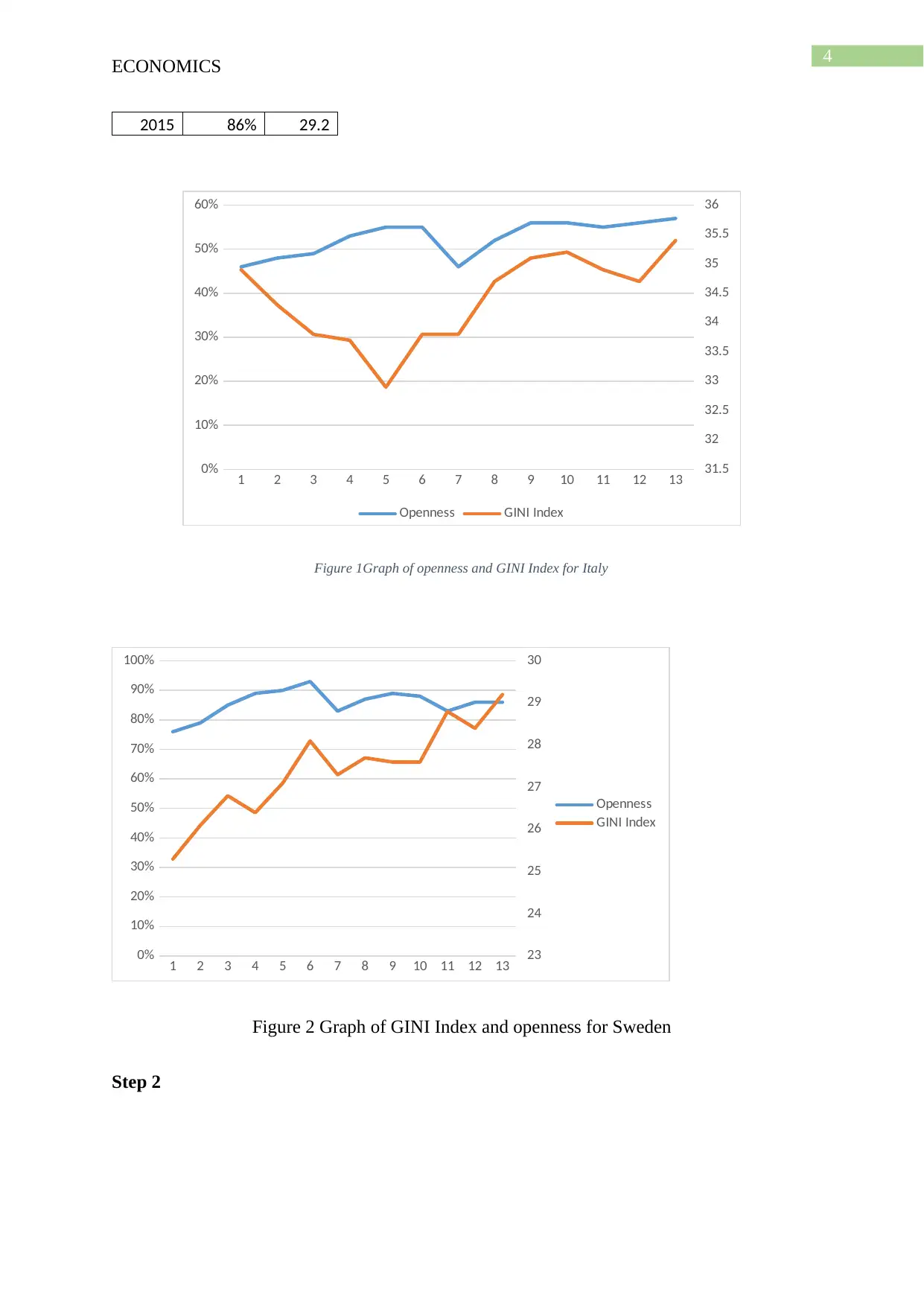
4
ECONOMICS
2015 86% 29.2
1 2 3 4 5 6 7 8 9 10 11 12 13
0%
10%
20%
30%
40%
50%
60%
31.5
32
32.5
33
33.5
34
34.5
35
35.5
36
Openness GINI Index
Figure 1Graph of openness and GINI Index for Italy
1 2 3 4 5 6 7 8 9 10 11 12 13
0%
10%
20%
30%
40%
50%
60%
70%
80%
90%
100%
23
24
25
26
27
28
29
30
Openness
GINI Index
Figure 2 Graph of GINI Index and openness for Sweden
Step 2
ECONOMICS
2015 86% 29.2
1 2 3 4 5 6 7 8 9 10 11 12 13
0%
10%
20%
30%
40%
50%
60%
31.5
32
32.5
33
33.5
34
34.5
35
35.5
36
Openness GINI Index
Figure 1Graph of openness and GINI Index for Italy
1 2 3 4 5 6 7 8 9 10 11 12 13
0%
10%
20%
30%
40%
50%
60%
70%
80%
90%
100%
23
24
25
26
27
28
29
30
Openness
GINI Index
Figure 2 Graph of GINI Index and openness for Sweden
Step 2
Paraphrase This Document
Need a fresh take? Get an instant paraphrase of this document with our AI Paraphraser
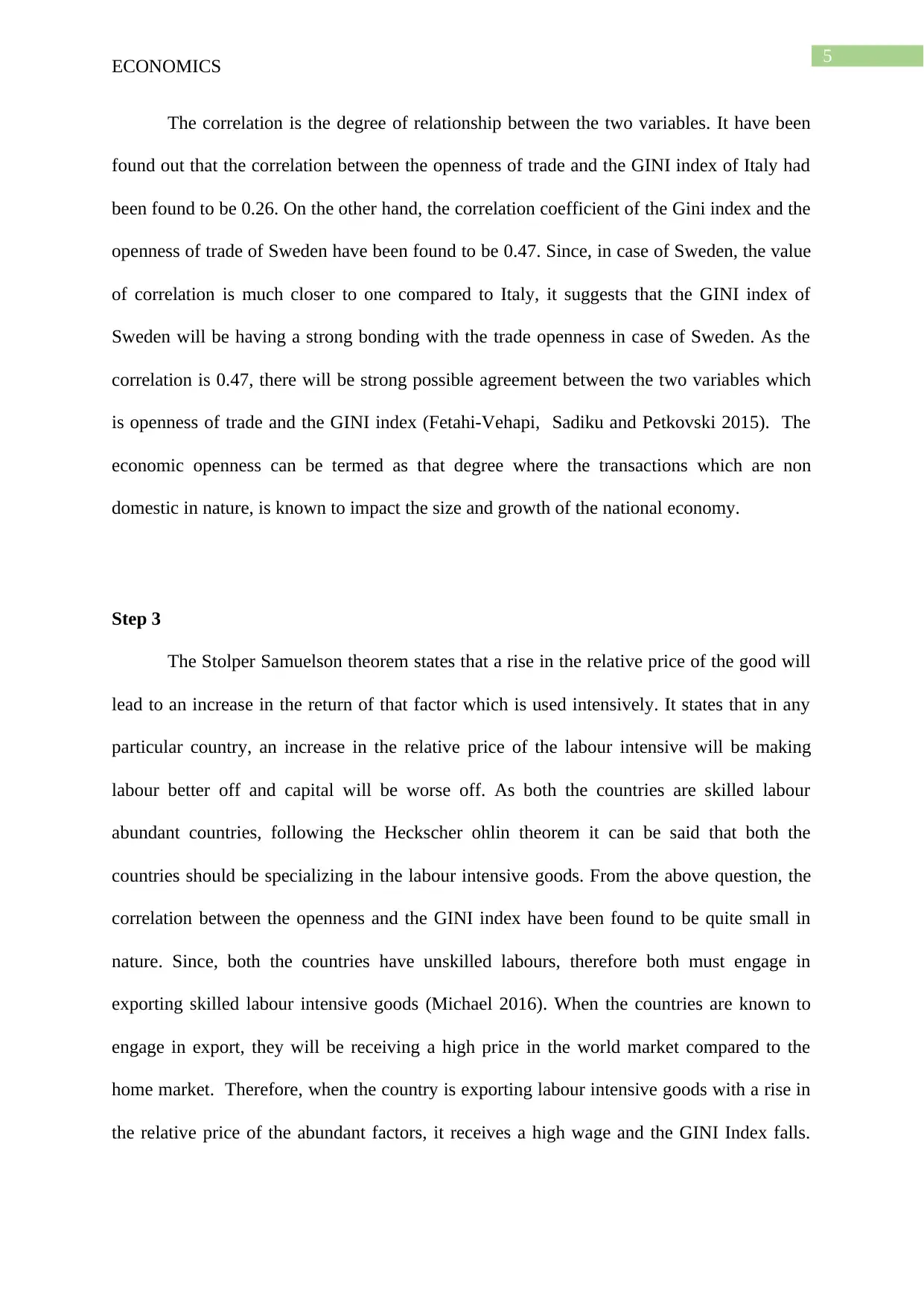
5
ECONOMICS
The correlation is the degree of relationship between the two variables. It have been
found out that the correlation between the openness of trade and the GINI index of Italy had
been found to be 0.26. On the other hand, the correlation coefficient of the Gini index and the
openness of trade of Sweden have been found to be 0.47. Since, in case of Sweden, the value
of correlation is much closer to one compared to Italy, it suggests that the GINI index of
Sweden will be having a strong bonding with the trade openness in case of Sweden. As the
correlation is 0.47, there will be strong possible agreement between the two variables which
is openness of trade and the GINI index (Fetahi-Vehapi, Sadiku and Petkovski 2015). The
economic openness can be termed as that degree where the transactions which are non
domestic in nature, is known to impact the size and growth of the national economy.
Step 3
The Stolper Samuelson theorem states that a rise in the relative price of the good will
lead to an increase in the return of that factor which is used intensively. It states that in any
particular country, an increase in the relative price of the labour intensive will be making
labour better off and capital will be worse off. As both the countries are skilled labour
abundant countries, following the Heckscher ohlin theorem it can be said that both the
countries should be specializing in the labour intensive goods. From the above question, the
correlation between the openness and the GINI index have been found to be quite small in
nature. Since, both the countries have unskilled labours, therefore both must engage in
exporting skilled labour intensive goods (Michael 2016). When the countries are known to
engage in export, they will be receiving a high price in the world market compared to the
home market. Therefore, when the country is exporting labour intensive goods with a rise in
the relative price of the abundant factors, it receives a high wage and the GINI Index falls.
ECONOMICS
The correlation is the degree of relationship between the two variables. It have been
found out that the correlation between the openness of trade and the GINI index of Italy had
been found to be 0.26. On the other hand, the correlation coefficient of the Gini index and the
openness of trade of Sweden have been found to be 0.47. Since, in case of Sweden, the value
of correlation is much closer to one compared to Italy, it suggests that the GINI index of
Sweden will be having a strong bonding with the trade openness in case of Sweden. As the
correlation is 0.47, there will be strong possible agreement between the two variables which
is openness of trade and the GINI index (Fetahi-Vehapi, Sadiku and Petkovski 2015). The
economic openness can be termed as that degree where the transactions which are non
domestic in nature, is known to impact the size and growth of the national economy.
Step 3
The Stolper Samuelson theorem states that a rise in the relative price of the good will
lead to an increase in the return of that factor which is used intensively. It states that in any
particular country, an increase in the relative price of the labour intensive will be making
labour better off and capital will be worse off. As both the countries are skilled labour
abundant countries, following the Heckscher ohlin theorem it can be said that both the
countries should be specializing in the labour intensive goods. From the above question, the
correlation between the openness and the GINI index have been found to be quite small in
nature. Since, both the countries have unskilled labours, therefore both must engage in
exporting skilled labour intensive goods (Michael 2016). When the countries are known to
engage in export, they will be receiving a high price in the world market compared to the
home market. Therefore, when the country is exporting labour intensive goods with a rise in
the relative price of the abundant factors, it receives a high wage and the GINI Index falls.
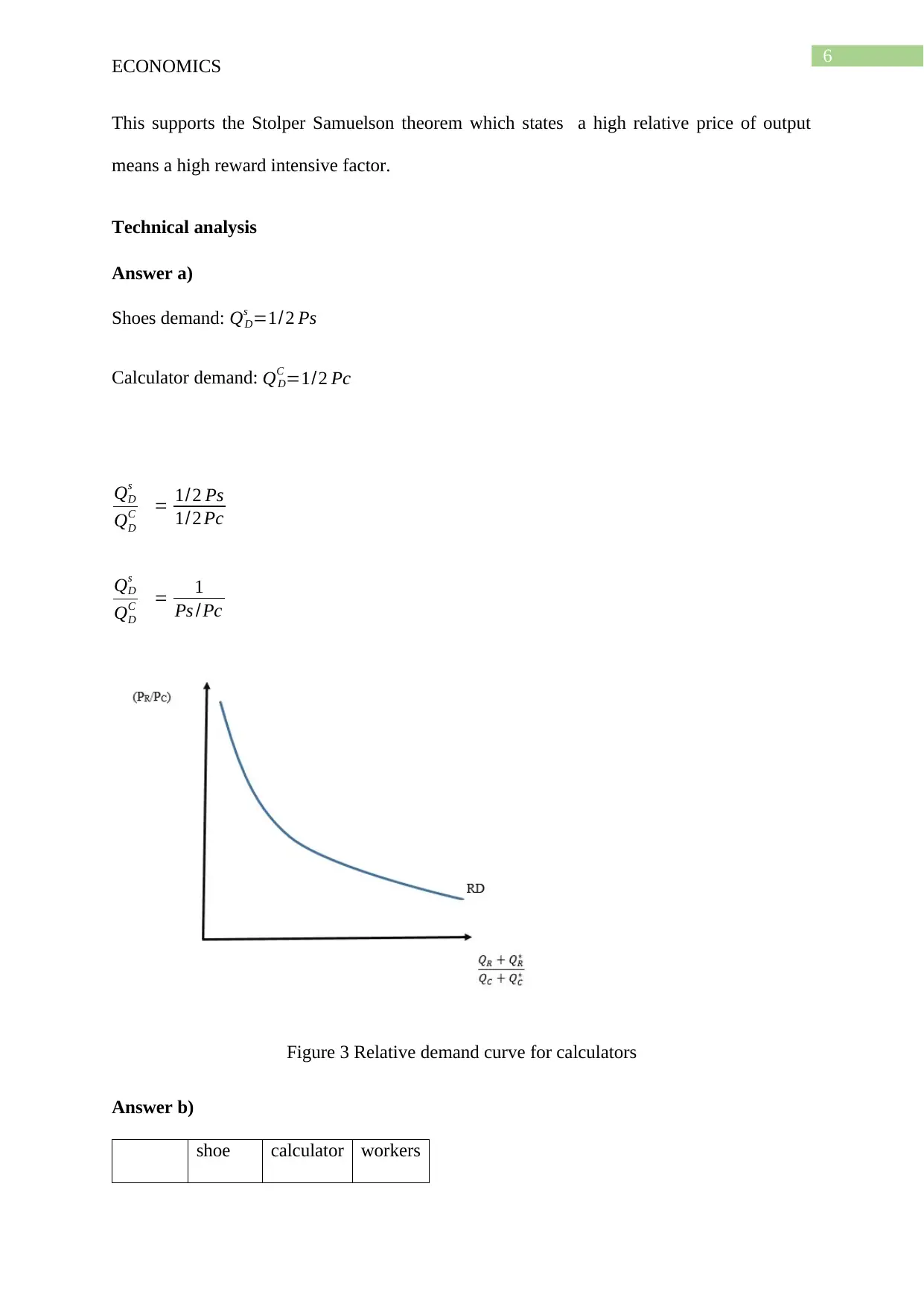
6
ECONOMICS
This supports the Stolper Samuelson theorem which states a high relative price of output
means a high reward intensive factor.
Technical analysis
Answer a)
Shoes demand: QD
s =1/2 Ps
Calculator demand: QD
C =1/2 Pc
QD
s
QD
C = 1/2 Ps
1/2 Pc
QD
s
QD
C = 1
Ps /Pc
Figure 3 Relative demand curve for calculators
Answer b)
shoe calculator workers
ECONOMICS
This supports the Stolper Samuelson theorem which states a high relative price of output
means a high reward intensive factor.
Technical analysis
Answer a)
Shoes demand: QD
s =1/2 Ps
Calculator demand: QD
C =1/2 Pc
QD
s
QD
C = 1/2 Ps
1/2 Pc
QD
s
QD
C = 1
Ps /Pc
Figure 3 Relative demand curve for calculators
Answer b)
shoe calculator workers
⊘ This is a preview!⊘
Do you want full access?
Subscribe today to unlock all pages.

Trusted by 1+ million students worldwide
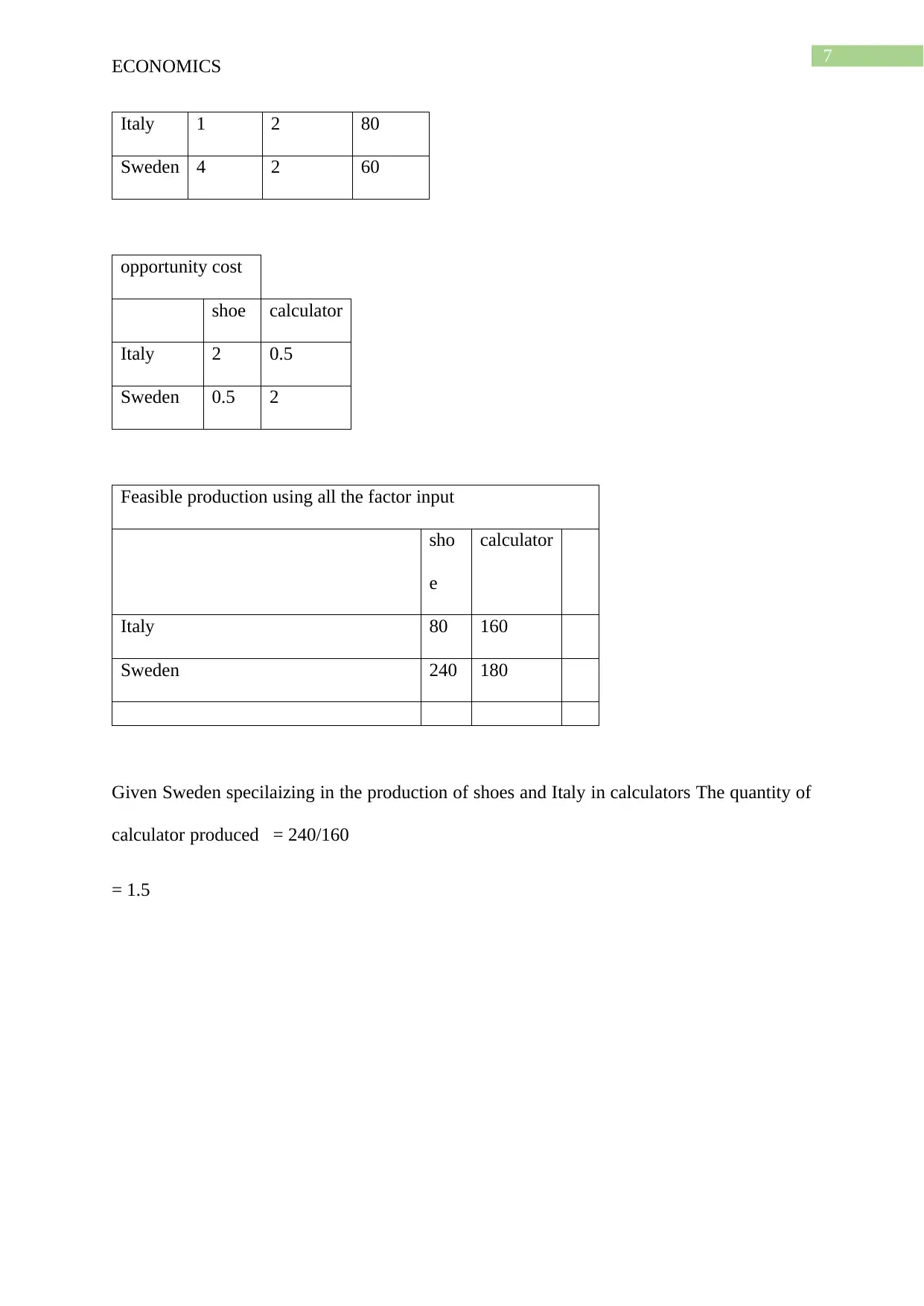
7
ECONOMICS
Italy 1 2 80
Sweden 4 2 60
opportunity cost
shoe calculator
Italy 2 0.5
Sweden 0.5 2
Feasible production using all the factor input
sho
e
calculator
Italy 80 160
Sweden 240 180
Given Sweden specilaizing in the production of shoes and Italy in calculators The quantity of
calculator produced = 240/160
= 1.5
ECONOMICS
Italy 1 2 80
Sweden 4 2 60
opportunity cost
shoe calculator
Italy 2 0.5
Sweden 0.5 2
Feasible production using all the factor input
sho
e
calculator
Italy 80 160
Sweden 240 180
Given Sweden specilaizing in the production of shoes and Italy in calculators The quantity of
calculator produced = 240/160
= 1.5
Paraphrase This Document
Need a fresh take? Get an instant paraphrase of this document with our AI Paraphraser

8
Sweden specializes in
shoe and Italy
specializes in
calculator.
QC*+QC/QS*+QS
ECONOMICS
Figure 4 World relative supply curve
Answer c)
QD
s
QD
C = 1
Ps /Pc
When QD
s
QD
C = 1.5
Ps/Pc= 1/1.5
= 0.66
This will be the world price under free trade
1.5
2
Pc/Ps
Sweden specializes in
shoe and Italy
specializes in
calculator.
QC*+QC/QS*+QS
ECONOMICS
Figure 4 World relative supply curve
Answer c)
QD
s
QD
C = 1
Ps /Pc
When QD
s
QD
C = 1.5
Ps/Pc= 1/1.5
= 0.66
This will be the world price under free trade
1.5
2
Pc/Ps

9
ECONOMICS
Figure 5 Equilibrium price and quantity under free trade
Answer d)
Under free trade Italy will be producing calculators and Sweden will be producing
shoes since they have opportunity cost in producing these goods.
Answer e)
Italy will be gaining from trade. It is known to obtain shoes at a much lower price
than the other country. The benefit to the labour can be understood from the consumer
equilibrium evaluation through budget line.
1.5
2
Qc/Qs = 1.5
ECONOMICS
Figure 5 Equilibrium price and quantity under free trade
Answer d)
Under free trade Italy will be producing calculators and Sweden will be producing
shoes since they have opportunity cost in producing these goods.
Answer e)
Italy will be gaining from trade. It is known to obtain shoes at a much lower price
than the other country. The benefit to the labour can be understood from the consumer
equilibrium evaluation through budget line.
1.5
2
Qc/Qs = 1.5
⊘ This is a preview!⊘
Do you want full access?
Subscribe today to unlock all pages.

Trusted by 1+ million students worldwide
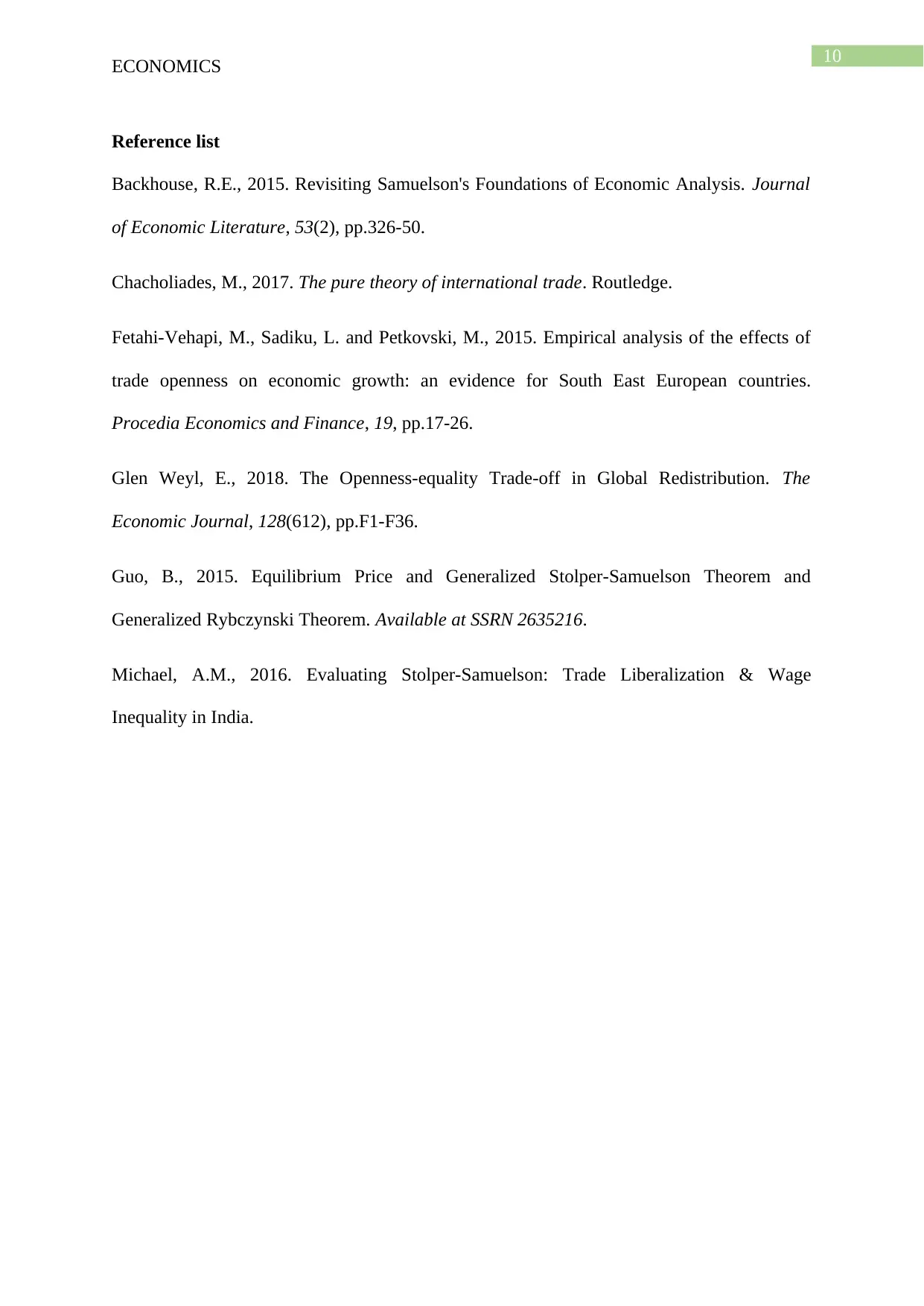
10
ECONOMICS
Reference list
Backhouse, R.E., 2015. Revisiting Samuelson's Foundations of Economic Analysis. Journal
of Economic Literature, 53(2), pp.326-50.
Chacholiades, M., 2017. The pure theory of international trade. Routledge.
Fetahi-Vehapi, M., Sadiku, L. and Petkovski, M., 2015. Empirical analysis of the effects of
trade openness on economic growth: an evidence for South East European countries.
Procedia Economics and Finance, 19, pp.17-26.
Glen Weyl, E., 2018. The Openness‐equality Trade‐off in Global Redistribution. The
Economic Journal, 128(612), pp.F1-F36.
Guo, B., 2015. Equilibrium Price and Generalized Stolper-Samuelson Theorem and
Generalized Rybczynski Theorem. Available at SSRN 2635216.
Michael, A.M., 2016. Evaluating Stolper-Samuelson: Trade Liberalization & Wage
Inequality in India.
ECONOMICS
Reference list
Backhouse, R.E., 2015. Revisiting Samuelson's Foundations of Economic Analysis. Journal
of Economic Literature, 53(2), pp.326-50.
Chacholiades, M., 2017. The pure theory of international trade. Routledge.
Fetahi-Vehapi, M., Sadiku, L. and Petkovski, M., 2015. Empirical analysis of the effects of
trade openness on economic growth: an evidence for South East European countries.
Procedia Economics and Finance, 19, pp.17-26.
Glen Weyl, E., 2018. The Openness‐equality Trade‐off in Global Redistribution. The
Economic Journal, 128(612), pp.F1-F36.
Guo, B., 2015. Equilibrium Price and Generalized Stolper-Samuelson Theorem and
Generalized Rybczynski Theorem. Available at SSRN 2635216.
Michael, A.M., 2016. Evaluating Stolper-Samuelson: Trade Liberalization & Wage
Inequality in India.
1 out of 10
Your All-in-One AI-Powered Toolkit for Academic Success.
+13062052269
info@desklib.com
Available 24*7 on WhatsApp / Email
![[object Object]](/_next/static/media/star-bottom.7253800d.svg)
Unlock your academic potential
Copyright © 2020–2025 A2Z Services. All Rights Reserved. Developed and managed by ZUCOL.